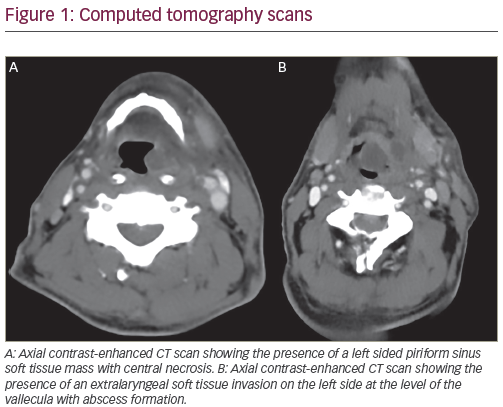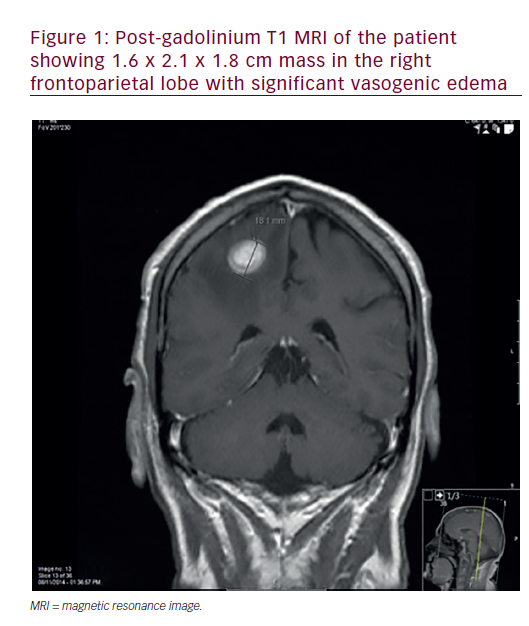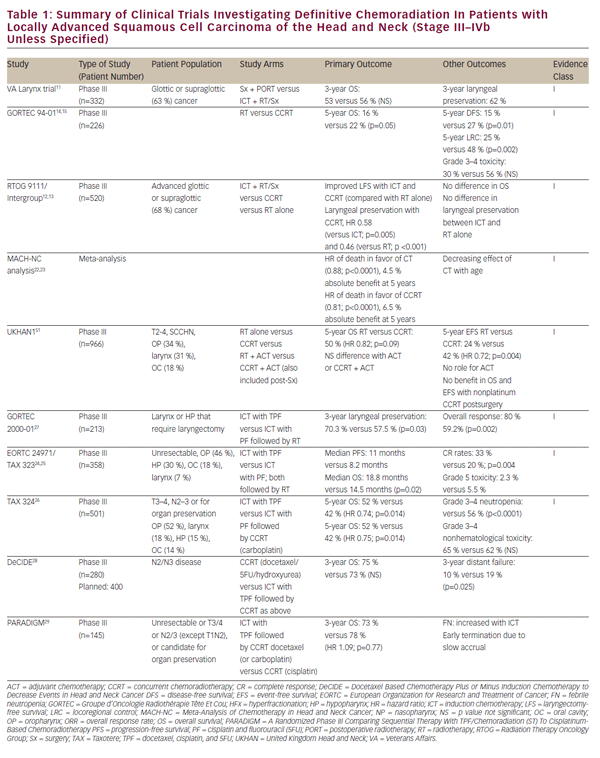Current Screening Practices Do Not Detect the Majority of Cancer Patients
OAC arises from Barrett’s oesophagus,4,11 a metaplastic process that occurs in response to the caustic effects of chronic gastro-oesophageal disease (GORD).3,4,12,13 It is thought that OAC develops through a metaplasia– dysplasia–carcinoma sequence in the face of chronic GORD.14,15 The risk of developing OAC in a field of Barrett’s is 0.5–1.0% per year.14 Without recognised clinical risk factors that signal the early development of oesophageal cancer, identification of early-stage disease is limited to endoscopic screening for Barrett’s in patients with chronic and severe symptoms of GORD.4,16,17 Those diagnosed with Barrett’s then undergo endoscopic surveillance for the development of malignancy every one to three years.16 Despite this, 95% of patients who develop OAC present with oesophageal obstruction secondary to advanced local disease and have never undergone Barrett’s screening.15–17 In addition, up to 57% of patients who develop OAC may not have ever reported GORD symptoms.12,21 Thus, if 40% of the cancer population lack alert symptoms, then screening and surveillance can prevent no more than 60% of cancer-related deaths.22
The implication is that the majority of patients who go on to develop malignancy are either not identified for Barrett’s screening because they do not have typical GORD symptoms, or they have signs and symptoms of GORD that are either unrecognised or not severe enough to trigger screening.21 The end result is that surveillance cannot be effective if the vast majority of patients who ultimately develop cancer are not screened, identified with Barrett’s, and then enrolled into surveillance programmes.An Incomplete Understanding of Prevalence Leads to Poor Understanding of Risk
The majority of what is known about the prevalence of Barrett’s and its clinical risk factors has been gleaned from highly selected populations in the US and Europe.22–30 As a result, the generalisation of findings to the larger US populace and our understanding of risk have been severely limited.31 This bias is the result of the cost, risk and complexity associated with sedated endoscopy, leading to a barrier to the ease and safety with which the oesophagus can be interrogated. Studies directed at defining Barrett’s prevalence and associated risk factors have been limited to patient populations undergoing clinically indicated endoscopic procedures such as colonoscopy. In addition, the wide regional variation in OAC rates may reflect a parallel heterogeneity in the prevalence of Barrett’s by region or country.32 This variation in cancer incidence implies that there may be significant modifiable environmental risk factors. Table 2 illustrates the wide range in the reported prevalence rates of Barrett’s in the US and Europe.
One study has examined the prevalence of Barrett’s in the general population of Sweden.33 A representative sample of two communities (19,000 inhabitants) underwent endoscopic screening. Of invited subjects, 74% responded to a mailed symptom questionnaire. Of those that were approached, 73% (n=1,000) underwent endoscopy. Barrett’s prevalence in this population was 1.6%. There was no significant difference in Barrett’s prevalence between those with and without GORD symptoms. With only 16 Barrett’s patients discovered in this study, useful risk stratification was limited. Study criticisms were related to the biopsy protocol used and the long study duration. In the editorial that accompanied this paper,31 Sampliner stated: “Many more steps are necessary before we [the US] can accurately identify both symptomatic and asymptomatic candidates appropriate to screen for Barrett’s. The major challenges include better risk stratification of symptomatic patients to reduce the volume of patients to be screened. Less invasive and less costly technology is needed to screen for Barrett’s. Defining the risk factors for people with Barrett’s lacking GORD symptoms is a new area requiring further investigation.”
Endoscopic Surveillance May Lead to Early Diagnosis and Improved Survival
As there are no dependable means by which to identify Barrett’s patients at risk for developing carcinoma, strong emphasis has been placed on endoscopic surveillance of all patients with Barrett’s.16,17 Despite questions pertaining to whether surveillance is economically tenable,22 this practice is driven by several uncontrolled studies that have revealed an earlier stage of diagnosis and a reduction in cancer-related mortality in patients undergoing endoscopic surveillance compared with no surveillance.34–38 Streitz and colleagues evaluated the clinical characteristics of 19 patients with surveillance-diagnosed OAC versus 58 patients who had not been screened for Barrett’s and presented with tumour-related signs or symptoms.34
The surveillance group was more likely to be diagnosed with stage 0 or I disease (58% surveillance versus 17% no surveillance) and less likely to have advanced disease (21% surveillance versus 47% no surveillance). Finally, the surveillance population had a higher five-year actuarial survival than the comparison group (62% versus 20%, respectively).
As there has not been a randomised trial conducted to address the effectiveness of surveillance, opponents to this practice are concerned that the positive results may reflect lead time or length time bias.39
Limitations to Widespread Endoscopic Screening
As there are a relatively small number of OAC cases per year and an extremely large pool of potential GORD patients to be screened, the practicality of this approach has been questioned.22,40 Shaheen and Ransohoff estimate that among 77 million Americans over age 50, 10 million people have weekly GORD symptoms and would require endoscopy if practitioners observed the current American Society for Gastrointestinal Endoscopy recommendations.16,41 Screening this population (and subsequent surveillance in those discovered to have Barrett’s) with sedated endoscopy would exhaust available resources.
With Markov modelling, Inadomi and colleagues established that screening followed by surveillance in Barrett’s patients with dysplasia appears to be feasible with an incremental cost-effectiveness ratio (ICER) of US$10,440 compared with no screening.42 However, surveillance in patients without dysplasia is prohibitive, with an ICER between US$381,543 and US$596,184 based on the surveillance interval. It is well established that the total cost of conventional endoscopy is inflated by the costs of medication and patient monitoring associated with sedation43 that requires the infrastructure and resources of an outpatient procedure unit, two assistants, intravenous sedation and post-procedure monitoring. Moreover, patients are subjected to the risks of conscious sedation, which are not insignificant.44–47 Finally, patients who undergo screening or surveillance endoscopy often miss an entire day of work46 and must arrange for third-party transportation to and from the hospital.
Despite efforts to explore less costly, non-endoscopic methods of screening and surveillance, none compare to the accuracy of endoscopic examination with biopsy.48 For endoscopic screening and surveillance of Barrett’s to be economically feasible, the sedationrelated cost and complexity inherent in this procedure must be reduced.49 Clearly, there is a need to simplify screening techniques and distill the most potent clinical risk factors for Barrett’s and OAC beyond the current GORD symptom-based paradigm.
Improving Risk Stratification with the Goal of Early Detection and Prolonged Survival – Where Do We Go from Here?
The current system employed for screening and surveillance of OAC is ineffective and impractical.50 It is essential that we aim to determine the prevalence of Barrett’s in a broad and unselected population. This will require a large-scale co-ordinated effort in which all major regions of the US are represented. Extensive clinical and laboratory risk factor data will need to be collected in order to broaden our understanding of Barrett’s risk outside the ‘traditional’ GORD symptom-based paradigm. What will most likely be required is the development of a probability model for the presence of Barrett’s that incorporates the most potent risk factors discovered in the ‘general population’ as a guide for screening threshold. These large-scale investigations will depend on the validation and implementation of novel endoscopic/imaging modalities that may be used to simplify screening and surveillance.
XS = cross-sectional; CS = case series; sxs = symptoms; A = autopsy.








